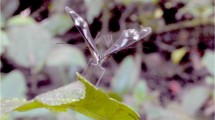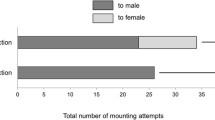Abstract
The major component (>90% of volatiles) of the male rectal glandular extract of the nonpest speciesBactrocera visenda (Hardy) is 3-methyl2-butenyl acetate, with minor components being the isomeric 3-methyl-3-butenyl acetate, the homologous esters, 3-methyl-2-butenyl propanoate and 3-methyl-2-butenyl formate, along with 3-methyl-2-buten-1-ol, 3-methyl-2-butenal, and 3-methylbutyl acetate. None of these compounds has been identified previously from aBactrocera species, supporting the view thatBactrocera visenda is taxonomically distant from otherBactrocera species identified from the Australian mainland. This collection of compounds adds to the known types utilized by dipteran species and emphasizes their extensive biosynthetic capability.
Similar content being viewed by others
References
Aljancic-Soloja, I., Rey, M., andDreiding, A.S. 1987. Short synthesis of (±) grandisol and (±)-lineatinvia a common intermediate.Helv. Chim. Acta 70:1302–1306.
Attygalle, A.B., Meinwald, J., andEisner, T. 1991. Biosynthesis of methacrylic acid and isobutyric acids in a carabid beetle,Scarites subterraneus.Tetrahedron Lett. 32:4849–4852.
Babin, D., Fourneron, J.D., andJulia, M. 1980. Condensations biomimetiques: edification de squelettes terpeniques.Bull. Soc. Chim. Fr. II:588–600.
Baker, R., Herbert, R.H., andLomer, R.A. 1982. Chemical components of the rectal gland secretions of maleDacus cucurbitae, the melon fly.Experientia 38:232–233.
Bellas, T.E., andFletcher, B.S. 1979. Identification of the major components in the secretion from rectal pheromone glands of the Queensland fruit fliesDacus tryoni andDacus neohumeralis (Diptera: Tephritidae).J. Chem. Ecol. 5:795–803.
Blomquist, G.J., Dillwith, J.W., andAdams, T.S. 1987. Biosynthesis and endocrine regulation of sex pheromone production in Diptera, pp. 217–250,in G.D. Prestwich and G.J. Blomquist (eds). Pheromone Biochemistry. Academic Press, New York.
Blum, M.S. 1981. Chemical Defenses of Arthropods. Academic Press, New York.
Blum, M.S., Fales, H.M., Tucker, K.W., andCollins, A.M. 1978. Chemistry of the sting apparatus in the worker honey bees.J. Apic. Res. 17:218–221.
Bradshaw, J.W.S. 1985. Insect natural products-compounds derived from acetate, shikimate and amino acids, pp. 655–703,in G.A. Kerkut and L.I. Gilbert (eds.). Comprehensive Insect Physiology, Biochemistry and Pharmacology, Vol. 11. Pergamon Press, Oxford.
Drew, R.A.I. 1989. The tropical fruit-flies (Diptera Tephritidae: Dacinae) of the Australasian and Oceanian regions.Mem. Qld. Mus. 26:1–521.
Drew, R.A.I., Hooper, G.H.S., andBateman, M.A. 1982. Economic Fruit Flies of the South Pacific Region. Queensland Department of Primary Industries, Brisbane.
Duffield, R.M., Ferands, A., Lamb, C., Wheeler, J.W., andEickworth, G.C. 1981. Macrocyclic lactones and isopentenylesters in the Dufour's gland secretion of halictine bees (Hymenoptera: Halictidae).J. Chem. Ecol. 7:319–331.
Duffield, R.M., La Berge, W.E., Cane, J.H., andWheeler, J.W. 1982. Exocrine secretions of bees IV. Macrocyclic lactones and isopentenylesters in Dufour's gland secretions ofNomia bees (Hymenoptera: Halictidae).J. Chem. Ecol. 8:535–543.
Fales, H.M., Blum, M.S., Bian, Z., Jones, T.H., andDon, A.W. 1984. Aliphatic amines from ponerine ants in the genusMesoponera.J. Chem. Ecol. 10:651–665.
Heath, R.R., andLandolt, P.J. 1988. The isolation, identification and synthesis of the alarm pheromone ofVespula squamosa (Drury) (Hymenoptera: Vespidae) and associated behaviour.Experientia 44:82–83.
Jang, E.B., Light, D.M., Flath, R.A., Nagata, J.T., andMon, T.R. 1989. Electroantennogram responses of the Mediterranean fruit fly,Ceratitis capitata to identify volatile constituents from calling males.Entomol. Exp. Appl. 50:7–19.
Kitching, W., Lewis, J.A., Perkins, M.V., Drew, R.A.I., Moore, C.J., Schurig, V., Konig, W.A., andFrancke, W. 1989. Chemistry of fruit-flies. Composition of the rectal gland secretion of (male)Dacus cucumis (cucumber fly) andDacus halfordiae.J. Org. Chem. 54:3893–3902.
Krohn, S., Fletcher, M.T., Kitching, W., Drew, R.A.I., Moore, C.J., andFrancke, W. 1991. Chemistry of fruit flies. Nature of the glandular secretion and volatile emission ofBactrocea (Bactrocera) cacuminatus (Hering).J. Chem. Ecol. 17:485–495.
Morse, R.A., Shearer, D.A., Boch, D.A., andBenton, A.W. 1967. Observations on alarm substances in the genusApis.J. Apic. Res. 6:113–118.
Morton, T.C., andBateman, M.A. 1981. Chemical studies on proteinaceous attractants for fruitflies, including the identification of volatile constituents.Aust. J. Agric. Res. 32:905–916.
Nazarov, I.N., Rakcheeva, V.N., andShmonina, L.I. 1952. Rearrangement of the allyl system. 5. Exchange reactions of 3,3-dimethylallyl chloride with amines, potassium cyanide, and salts of organic acids.Zhur. Obshchei Khim. 22:611–617. (Chem. Abst. 47:5370b, 1953).
Pauling, H., Andrews, D.A., andHindley, N.C. 1976. The rearrangement ofα-acetylenic alcohols toα,β-unsaturated carbonyl compounds by silylvanadate catalysts.Helv. Chim. Acta 59:1233–1243.
Perkins, M.V., Fletcher, M.T., Kitching, W. Drew, R.A.I., andMoore, C.J. 1990a. Chemical studies of the rectal secretions of some species of theBactrocera dorsalis complex of fruit flies (Diptera: Tephritidae).J. Chem. Ecol. 16:2475–2487.
Perkins, M.V., Kitching, W., Konig, W.A., Drew, R.A.I., andMoore, C.J. 1990b. Chemistry of fruit-flies. Composition of the rectal gland secretions of (male) South-East Asian fruit flies. Re-examination ofDacus cucurbitae (melon fly).J. Chem. Soc. Perkin I:1111–1117.
Shiota, H., Young, H., Paterson, V.J., andIrie, M. 1988. Volatile aroma constituents of pepino fruit.J. Sci. Food. Agric. 43:343–354 (this paper summarizes the occurrence of 1, 2, 5, and 7 in other fruits).
Takeoka, G.R., Flath, R.A., Guntert, M., andJennings, W. 1988. Nectarine volatiles: Vacuum steam distillation versus headspace sampling.J. Agric. Food. Chem. 36:553–560.
Tumlinson, J.H. 1989. Insect chemical communication systems.Pure Appl. Chem. 61:559–562.
Wheeler, J.W., Shamin, M.T., Browne, P., andDuffield, R.M. 1983. Semiterpenoid esters from the venom of the European hornet,Vespa crabro (Hymenoptera: Vespidae).Tetrahedron Lett. 24:5811–5819.
Author information
Authors and Affiliations
Rights and permissions
About this article
Cite this article
Krohn, S., Fletcher, M.T., Kitching, W. et al. Chemistry of fruit flies: Glandular secretion ofBactrocera (Polistomimetes) visenda (Hardy). J Chem Ecol 18, 2169–2176 (1992). https://doi.org/10.1007/BF00984944
Received:
Accepted:
Issue Date:
DOI: https://doi.org/10.1007/BF00984944




